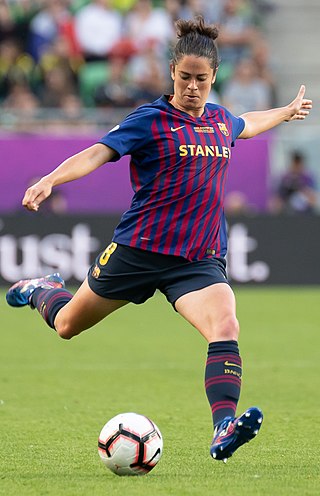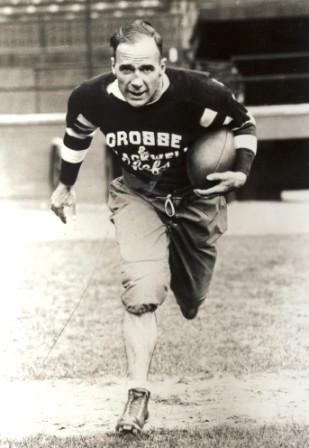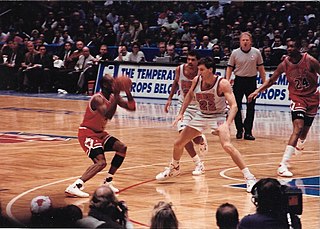
A football player or footballer is a sportsperson who plays one of the different types of football. The main types of football are association football, American football, Canadian football, Australian rules football, Gaelic football, rugby league, and rugby union.
In professional sports, a salary cap is an agreement or rule that places a limit on the amount of money that a team can spend on players' salaries. It exists as a per-player limit or a total limit for the team's roster, or both. Several sports leagues have implemented salary caps, using them to keep overall costs down, and also to maintain a competitive balance by restricting richer clubs from entrenching dominance by signing many more top players than their rivals. Salary caps can be a major issue in negotiations between league management and players' unions because they limit players' and teams' ability to negotiate higher salaries even if a team is operating at significant profits, and have been the focal point of several strikes by players and lockouts by owners and administrators.
A head coach, senior coach, or manager is a professional at training and developing athletes. They typically hold a more public profile and are paid more than other coaches. In some sports, the head coach is instead called the "manager", as in association football and professional baseball. In other sports, such as Australian rules football, the head coach is generally referred to as the senior coach.

Amateur sports are sports in which participants engage largely or entirely without remuneration. The distinction is made between amateur sporting participants and professional sporting participants, who are paid for the time they spend competing and training. In the majority of sports which feature professional players, the professionals will participate at a higher standard of play than amateur competitors, as they can train full-time without the stress of having another job. The majority of worldwide sporting participants are amateurs.
Minor leagues are professional sports leagues which are not regarded as the premier leagues in those sports. Minor league teams tend to play in smaller, less elaborate venues, often competing in smaller cities/markets. This term is used in North America with regard to several organizations competing in various sports. They generally have lesser fan bases, much smaller revenues and salaries, and are used to develop players for bigger leagues.
The reserve clause, in North American professional sports, was part of a player contract which stated that the rights to players were retained by the team upon the contract's expiration. Players under these contracts were not free to enter into another contract with another team. Once signed to a contract, players could, at the team's discretion, be reassigned, traded, sold, or released.
A luxury tax in professional sports is a surcharge put on the aggregate payroll of a team to the extent to which it exceeds a predetermined guideline level set by the league. The ostensible purpose of this "tax" is to prevent teams in major markets with high incomes from signing almost all of the more talented players and hence destroying the competitive balance necessary for a sport to maintain fan interest. The money derived from the "tax" is either divided among the teams that play in the smaller markets, presumably to allow them to have more revenue to devote toward the contracts of high-quality players, or in the case of Major League Baseball, used by the league for other pre-defined purposes.

An exhibition game is a sporting event whose prize money and impact on the player's or the team's rankings is either zero or otherwise greatly reduced. Exhibition games often serve as "warm-up matches", particularly in many team sports where these games help coaches and managers select and condition players, before the competitive matches of a league season or tournament. If the players usually play in different teams in other leagues, exhibition games offer an opportunity for the players to learn to work with each other. The games can be held between separate teams or between parts of the same team.
Semi-professional sports are sports in which athletes are not participating on a full-time basis, but still receive some payment. Semi-professionals are not amateur because they receive regular payment from their team, but generally at a considerably lower rate than a full-time professional athlete. As a result, semi-professional players frequently have full-time employment elsewhere. A semi-pro player or team could also be one that represents a place of employment that only the employees are allowed to play on. In this case, it is considered semi-pro because their employer pays them, but for their regular job, not for playing on the company's team.

Lionel Pretoria Conacher, nicknamed "The Big Train", was a Canadian athlete and politician. Voted the country's top athlete of the first half of the 20th century, he won championships in numerous sports. His first passion was Canadian football; he was a member of the 1921 Grey Cup champion Toronto Argonauts. He was also a member of the Toronto Maple Leafs baseball team that won the International League championship in 1926. In hockey, he won a Memorial Cup in 1920, and the Stanley Cup twice: with the Chicago Black Hawks in 1934 and the Montreal Maroons in 1935. Additionally, he won wrestling, boxing and lacrosse championships during his playing career. He is one of three players, including Joe Miller and Carl Voss, to have their names engraved on both the Grey Cup and Stanley Cup.

Sports in the United States are an important part of the nation's culture. Historically, the national sport has been baseball. However, in more recent decades, American football has been the most popular sport in terms of broadcast viewership audience. Basketball has grown into the mainstream American sports scene since the 1980s, with ice hockey and soccer doing the same around the turn of the 21st century. These sports comprise the "Big Five".

Women's professional sports are a relatively new phenomenon, having largely emerged within the latter part of the 20th century. Unlike amateur female athletes, professional female athletes are able to acquire an income which allows them to earn a living without requiring another source of income. In international terms, most top female athletes are not paid and work full-time or part-time jobs in addition to their training, practice, and competition schedules. Professional organizations for women in sport are most common in developed countries where there are investors available to buy teams and businesses which can afford to sponsor them in exchange for publicity and the opportunity to promote a variety of their products. Very few governments support professional sports, male or female. Today there are a number of professional women's sport leagues in the United States and Canada.

Major professional sports leagues in the United States and Canada traditionally include four leagues: Major League Baseball (MLB), the National Basketball Association (NBA), the National Football League (NFL), and the National Hockey League (NHL). Other prominent leagues include Major League Soccer (MLS) and the Canadian Football League (CFL).

Professional ice hockey (hockey) is the competition of ice hockey in which participants are paid to play. Professional competition began in North America in the United States—in Pennsylvania and Michigan—and in Canada around 1900. Professional ice hockey expanded across Canada and the United States and eventually to many other countries. There are major leagues around the world, including the National Hockey League in North America, the Kontinental Hockey League in Europe and Asia, and the Swedish Hockey League in Europe, as well as minor leagues such as the American Hockey League and ECHL in North America, and the Ligue Nord-Américaine de Hockey in Canada. High-level professional hockey is also present in Germany, the Czech Republic, Slovakia, Finland and Switzerland; professional hockey is also played in many other countries, as diverse as Ukraine, the United Kingdom, Austria, Australia and Japan. The major professional women's league is the Professional Women's Hockey League, which began play in 2024.
Issues related to race and sports have been examined by scholars for a long time. Among these issues are racial discrimination in sports as well as the observation that there are overrepresentations and underrepresentations of different races in different sports.
The personal finances of professional American athletes is a subject of widespread discussion due to the often high salaries of such athletes and the high rates of personal bankruptcy and other financial distress.
The prominent women's sports leagues in the United States and Canada serve as the pinnacle of women's athletic competition in North America. The United States is home to the vast majority of professional women's leagues. In North America, the top women's leagues feature both team sports and individual athletes. While some leagues have paid professional female athletes, others do not and function at a semi-professional level.
The history of Canadian sports falls into five stages of development: early recreational activities before 1840; the start of organized competition, 1840–1880; the emergence of national organizations, 1882–1914; the rapid growth of both amateur and professional sports, 1914 to 1960; and developments of the last half-century. Some sports, especially ice hockey, lacrosse, curling, and ringette enjoy an international reputation as particularly Canadian. Although typically thought of as American, the origin of the sport of baseball began the Canadian town of Beachville, Ontario, and American football was initially developed by Canadians at McGill University before two different playing styles emerged, American football and Canadian football. Canadian sports attract large numbers of participants and huge audiences; hockey, played by 1.4 million Canadians, has become part of the national identity.

Professional sports leagues in the United States includes major professional sports leagues, other highest-level professional leagues, and minor leagues.
The North American continent is the birthplace of several organized sports, such as basketball, charrería/rodeo, gridiron football, ice hockey, jaripeo/bull riding, lacrosse, ollamaliztl, mixed martial arts (MMA), padel, pickleball, racquetball, ultimate, and volleyball. The modern versions of baseball and softball, skateboarding, snowboarding, stock car racing, and surfing also developed in North America.











